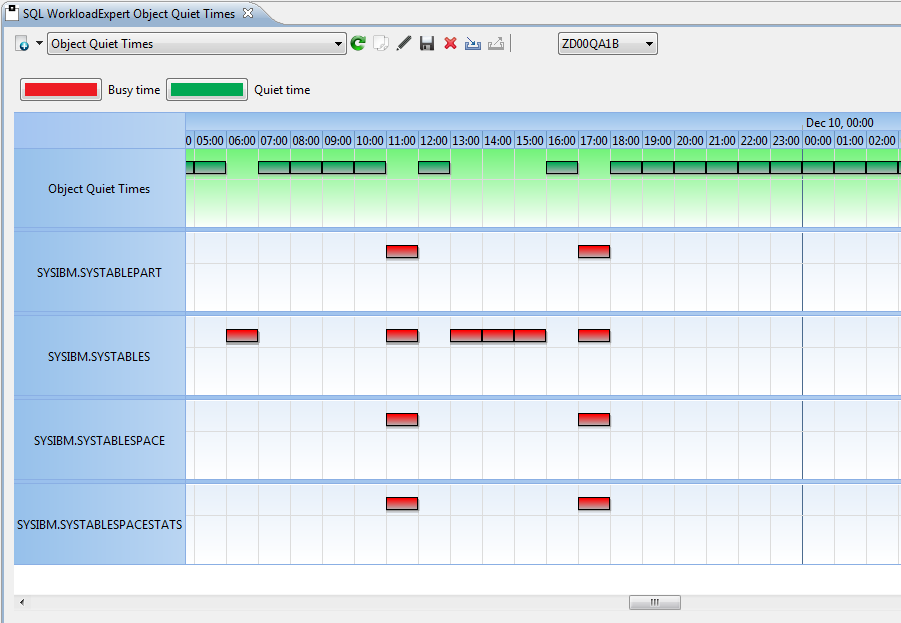How will you deal with loop-hole usage in production code?
The IFCIDs 366 and 376
DB2 provides many and varied IFCIDs. But for today, I’m most interested in the 366 and 376. The 366 is available in DB2 10 and the 376 in DB2 11. Now I like to call these “BIFCIDs” because they are triggered whenever a BIF is used that will behave differently than it is currently used when moving to the next release of DB2. (It’s also triggered when changing Application Compatibility settings in DB2 11 and higher).
So where’s the BIF?
BIF Usage Video (11min:) Presentation
Well, a BIF is a Built-In Function such as CHAR, DECIMAL, etc. There are hundreds of them these days. In the last few DB2 releases, IBM has changed a few to make DB2 more compatible with SQL standards. They have actually closed a couple of loop-holes, where “bad” data could be accepted and processed.
Loop-hole user?
What happens is: someone somewhere found this loop-hole and used it in production code. Now when you upgrade your DB2, this code will either fail or give erroneous results – which is never good. Hence IBM created the IFCID 366. This is output every time an SQL statement is PREPARED, or executed, that contains a candidate BIF. There were so many of these, that IBM introduced a sort of condensed version so it only triggered one for the first execution, or prepare, but sadly that IFCID—376—is only for DB2 11.
Where can, or will, this really hurt?
Looking into the documentation for these IFCIDs you will see a long list of when they are written:
***********************************************************************
** IFCID 0366 is a serviceability trace. **
** It can be used to identify applications that are affected **
** by incompatible changes. **
** The QW0366FN field indicates the type of incompatible Change: **
** **
** QW0366FN = 1 **
** Indicates that the pre Version 10 CHAR built-in function has **
** been invoked. There is an incompatible change to the output of **
** the CHAR function for some decimal data. The zparm **
** BIF_COMPATIBILITY and/or the SYSCOMPAT_V9 schema have been used **
** by this application to get the old behavior. Please make the **
** appropriate changes and rebind with the SYSCURRENT schema to **
** use the Version 10 CHAR(decimal) built-in function. **
** (PM29124 V10 only, usermod V8/V9) **
** **
** QW0366FN = 2 **
** Indicates that the pre Version 10 VARCHAR built-in function or **
** CAST(decimal AS CHAR or VARCHAR) has been invoked. **
** **
** QW0366FN = 3 **
** Indicates that an unsupported character representation of a **
** timestamp string was used. PM48741 V10 only. **
** **
** QW0366FN = 4 **
** A QW0366FN 4 record indicates that the statement uses the **
** word ARRAY_EXISTS as an unqualified user-defined function Name **
** in a context that may be incompatible with Version 11. **
** **
** QW0366FN = 5 **
** A QW0366FN 5 record indicates that the statement uses the **
** word CUBE as an unqualified user-defined function Name **
** in a context that may be incompatible with Version 11. **
** **
** QW0366FN = 6 **
** A QW0366FN 6 record indicates that the statement uses the **
** word ROLLUP as an unqualified user-defined function Name **
** in a context that may be incompatible with Version 11. **
** **
** QW0366FN = 7 **
** A QW0366FN 7 record indicates that DB2 for z/OS server issued **
** a SQLCODE -301 for incompatible data type conversion from **
** string data type (e.g. CHAR, VARCHAR, GRAPHIC, VARGRAPHIC **
** etc.) to numeric data type in V10 CM mode when implicit **
** cast is not supported or V10 NFM mode when DDF_COMPATIBILITY **
** zparm is set to DISABLE_IMPCAST_NJV or SP_PARMS_NJV to **
** disable implicit cast, and the client is CLI Driver **
** or v11 NFM mode & APPLCOMPAT = V10R1 when DDF_COMPATIBILITY **
** is set to SP_PARMS_NJV or DISABLE_IMPCAST_NJV to disable **
** implicit cast either from string data type to numeric or **
** from numeric data type to string data type. **
** **
** QW0366FN = 8 **
** A QW0366FN 8 record indicates that DB2 for z/OS server **
** returned output data match the data types of the **
** corresponding CALL statement arguments when DDF_COMPATIBILITY **
** zparm is set to SP_PARMS_NJV. **
** **
** QW0366FN = 9 **
** A QW0366FN 9 record indicates a data type conversion from **
** a TIMESTAMP WITH TIME ZONE input to a TIMESTAMP data **
** during input host variable bind-in process on server when **
** DDF_COMPATIBILITY zparm is set to IGNORE_TZ to ignore the **
** time zone information sent by Java IBM Data Server Driver. **
** **
** QW0366FN = 10 **
** RTRIM, LTRIM or STRIP version 9 being used with mixed data **
** **
** QW0366FN = 1101 **
** Indicates that the INSERT statement that inserts into an XML **
** column without XMLDOCUMENT function has been processed (which **
** should result in SQLCODE -20345 when run on DB2 release prior **
** to V11). Starting with V11, SQL error will no longer be issued. **
** Application will no longer recieve SQLCODE for this Statement. **
** **
** QW0366FN = 1102 **
** Indicates that V10 XPath evaluation behavior was in effect which **
** resulted in an error. For instance, a data type conversion error **
** could have occured for a predicate that would otherwise be **
** evaluated to false. Starting from V11, such "irrelevant" Errors **
** might be suppressed so an application might no longer recieve **
** the SQLCODE for this Statement. **
** **
** QW0366FN = 1103 **
** Indicates that a dynamic SQL uses the ASUTime limit that has **
** been set for the entire thread for RLF reactive governing. **
** For instance, when a dynamic SQL is processed from package A, **
** if the ASUTime limit is already set during other dynamic SQL **
** processing from package B in the same thread, the SQL from **
** package A will use the ASUTime limit set during the SQL **
** processing from package B. Stating with v11, dynamic SQLs from **
** multiple packages will use the ASUTime limit that is set **
** considering its own package information. **
** **
** QW0366FN = 1104, 1105, 1106, 1107 **
** Indicates that CLIENT special register (CLIENT_USERID, **
** CLIENT_WRKSTNNAME, CLIENT_APPLNAME, CLIENT_ACCTNG) has been set **
** to a value that is longer than what is supported prior to V11. **
** A shorter value has been used instead. **
** **
** QW0366FN = 1108 **
** Indicates that CLIENT special register (CLIENT_USERID, **
** CLIENT_WRKSTNNAME, CLIENT_APPLNAME, CLIENT_ACCTNG) has been set **
** to a value that is longer than what is supported prior to V11. **
** Truncated values upto the supported lengths prior to v11 have **
** been used for RLF table search instead. **
** **
** QW0366FN = 1109 **
** Indicates that CAST(string AS TIMESTAMP) was processed for the **
** input string of length 8 and input was treated as a store clock **
** value (or input string was of length 13 and was treated as a **
** GENERATE_UNIQUE value). This behavior is incorrect for a CAST **
** and is valid for TIMESTAMP built-in function only. This behavior **
** is being corrected in DB2 11 so that input to CAST is not **
** treated as a store clock value nor GENERATE_UNIQUE. **
** **
** QW0366FN = 1110 **
** Indicates the integer argument of SPACE function is greater **
** than 32764. **
** **
** QW0366FN = 1111 **
** Indicates the optional integer argument of VARCHAR function **
** has a value greater than 32764. * **
***********************************************************************
Useful stuff indeed!
Phew! Not a bad list, huh? Now you see why these IFCIDs are so useful. It could well be, that you have none of these “alive” in your system today. Or, of course, it could be that you get millions of the things! Somehow you will have to work out a way to save the data, analyse it to get to the root cause, and then, finally, fix the problem(s).
Saved by APPLCOMPAT?
You could argue that the new DB2 11 parameter Application Compatibility will save you, but this is really a false economy. All it enables is the guarantee that the code will still “run”. However, in two more DB2 releases the code will fail and, in two more releases – so about six years – who will even know *how* to change which piece of source code and, perhaps even, where is that source code?
Saved by BIFCIDs
Personally, what I would do, is : to run our SQL WorkloadExpert tool to trap all the required [B]IFCIDs for a few hours (at first!).Then I would analyse the results, fix the code where it needs fixing – and repeat! I would keep doing this until no IFCID records are coming out and I would be set!
BIF Usage Video (11min:) Presentation
What is even better, is that our SQL WorkloadExpert will work correctly even when any new QW0366FN values appear – so when IBM decides to add another code (Like the new values 9 and 10 above for example) this BIF Usage still works correctly.
Of course, you may have another tool that you use at your site.
Can it see “Where’s the BIF?”
How will you deal with loop-hole usage in production code?
As usual, any question or comments gladly welcome!
TTFN
Roy Boxwell




